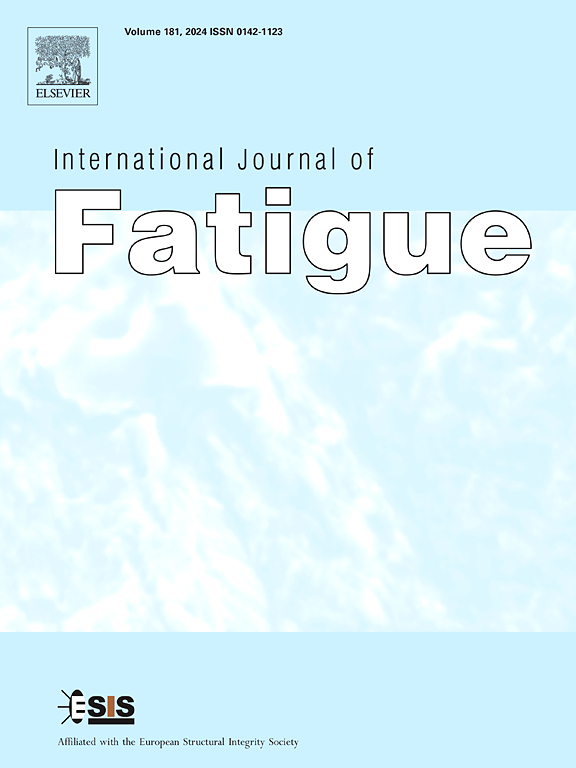基于缺陷的L-PBF Ti-6Al-4V合金多轴高周疲劳寿命预测临界平面法
IF 6.8
2区 材料科学
Q1 ENGINEERING, MECHANICAL
引用次数: 0
摘要
将基于缺陷的临界平面法与临界距离理论相结合,提出了一种激光粉末床熔合Ti-6Al-4V合金多轴高周疲劳寿命预测方法。采用极值统计法确定了引起疲劳失效的典型缺陷尺寸。选取基于优势失效模式的临界平面损伤参数,进行准确的寿命预测。对于以拉伸为主的材料,将临界面定义为最大开口应力面,并将有效裂纹驱动力修正的Smith-Watson-Topper (SWT)参数与TCD相结合进行寿命预测。对于以剪切为主破坏的材料,将其临界面定义为最大剪应力面,并将有效裂纹驱动力修正后的fatemi - society (FS)参数与TCD相结合进行寿命预测。采用不同后处理的L-PBF Ti-6Al-4V合金疲劳试验数据验证了该方法的有效性。结果表明,92%的预测寿命点落在±2个标准差范围内,8%的预测寿命点落在±2和±3个标准差范围内。本文章由计算机程序翻译,如有差异,请以英文原文为准。
A defect-based critical plane method for multiaxial high cycle fatigue life prediction in L-PBF Ti-6Al-4V alloy
A multiaxial high cycle fatigue (HCF) life prediction method is proposed for the laser powder bed fusion (L-PBF) Ti-6Al-4V alloy by integrating the defect-based critical plane method with the Theory of Critical Distances (TCD). The typical defect size inducing fatigue failure is determined by extreme value statistics. The critical plane damage parameters based on the dominant failure modes are selected for accurate life prediction. For materials exhibiting tensile-dominated failure, the critical plane is defined as the maximum opening stress plane, and the Smith-Watson-Topper (SWT) parameter modified by the effective crack driving force is combined with the TCD to predict life. For materials exhibiting shear-dominated failure, the critical plane is defined as the maximum shear stress plane, and the Fatemi-Socie (FS) parameter modified by the effective crack driving force is coupled with the TCD to predict life. The proposed method is validated using fatigue test data of L-PBF Ti-6Al-4V alloys subjected to diverse post-processing treatments. The results demonstrate that 92% of the predicted life points fall within ± 2 standard deviation scatter bands, while the remaining 8% lie between ± 2 standard deviation scatter bands and ± 3 standard deviation scatter bands.
求助全文
通过发布文献求助,成功后即可免费获取论文全文。
去求助
来源期刊

International Journal of Fatigue
工程技术-材料科学:综合
CiteScore
10.70
自引率
21.70%
发文量
619
审稿时长
58 days
期刊介绍:
Typical subjects discussed in International Journal of Fatigue address:
Novel fatigue testing and characterization methods (new kinds of fatigue tests, critical evaluation of existing methods, in situ measurement of fatigue degradation, non-contact field measurements)
Multiaxial fatigue and complex loading effects of materials and structures, exploring state-of-the-art concepts in degradation under cyclic loading
Fatigue in the very high cycle regime, including failure mode transitions from surface to subsurface, effects of surface treatment, processing, and loading conditions
Modeling (including degradation processes and related driving forces, multiscale/multi-resolution methods, computational hierarchical and concurrent methods for coupled component and material responses, novel methods for notch root analysis, fracture mechanics, damage mechanics, crack growth kinetics, life prediction and durability, and prediction of stochastic fatigue behavior reflecting microstructure and service conditions)
Models for early stages of fatigue crack formation and growth that explicitly consider microstructure and relevant materials science aspects
Understanding the influence or manufacturing and processing route on fatigue degradation, and embedding this understanding in more predictive schemes for mitigation and design against fatigue
Prognosis and damage state awareness (including sensors, monitoring, methodology, interactive control, accelerated methods, data interpretation)
Applications of technologies associated with fatigue and their implications for structural integrity and reliability. This includes issues related to design, operation and maintenance, i.e., life cycle engineering
Smart materials and structures that can sense and mitigate fatigue degradation
Fatigue of devices and structures at small scales, including effects of process route and surfaces/interfaces.
 求助内容:
求助内容: 应助结果提醒方式:
应助结果提醒方式:


